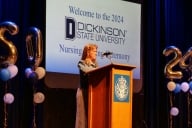You have /5 articles left.
Sign up for a free account or log in.
It may seem counterintuitive, but the best places to look for new sources of money could be the ones already bringing it in.
As the main source of revenue at liberal arts colleges – tuition from traditional-age students – becomes increasingly constrained by market forces, colleges are looking for new ways to generate revenue to sustain their costly educational model. While some have added new graduate-degree or preprofessional programs to attract new groups of students, a handful have been reluctant to follow that path, saying it strays from the liberal arts and the colleges' institutional mission.
Finding revenue opportunities that fit into those limited constraints – besides just hoping for the market to turn around – has been difficult for many.
But the experiences of two colleges – Central College in Iowa and Concordia College in Minnesota -- illustrate a growing trend in the sector: taking existing infrastructure and strengths and trying to find new ways to squeeze new revenue out of them. For these two colleges, opening up traditionally strong programs to new markets such as other institutions’ faculty members and corporate partners represent potential ways to increase revenue and decrease dependence on traditional sources of tuition. For Central, that means running faculty- and potentially corporate-development workshops through its study-abroad infrastructure. For Concordia, that means hosting corporate groups at its language villages.
“Our member institutions have always been fairly entrepreneurial,” said Richard Ekman, president of the Council of Independent Colleges, which represents more than 600 private four-year colleges and universities. Ekman said finding new sources of revenue is something colleges have done for years, and colleges need to be entrepreneurial in the face of constraints.
Revenue Question
In a recent survey of college and university business officers conducted by Inside Higher Ed, 82 percent of business officers at private baccalaureate institutions said they were focused on increasing net tuition revenue as a strategy to increase revenue. At the same time, more than two-thirds of business officers at private baccalaureate colleges said they were paying more attention to market limits on the ability to raise fees than five years ago, highlighting a need to think about raising revenue in new ways.
More broadly, 40 percent of respondents from all sectors said the business model of private four-year institutions that do not have significant endowments is “unsustainable and must change,” the highest for any sector. Unlike large research universities, college administrators say, small institutions do not have the type of overhead where significant savings can be found.
Moody’s Investors Service and Standard and Poor’s both recently released reports on how families, while still valuing higher education, are being more discriminating about how they spend their money. That trend could be bad for expensive but not elite private colleges.
In the past year there have been several conferences about the future of liberal arts education, many touching on this question of finding new revenue sources.
Studying Study Abroad
Central College President Mark Putnam is a big believer in traditional liberal arts education. Even though that his institution does not have the same financial resources as elite colleges and universities – its endowment was valued at $75 million in June 2011 – he has pushed back against the refrain that institutions like his are doomed.
He is also reluctant to add programs to the institution’s repertoire for financial reasons that don’t mesh with the institutional goals. But the college has recently found one opportunity that’s both “mission-driven and market-smart,” Putnam said: study abroad.
Central examined its study abroad programs over the past few years and is in the process of thinking strategically about how to change them. Administrators said the reasons why students study abroad have evolved since Central began offering is programs and that the college is rethinking what it should be offering. “There are a lot of reasons why one should study abroad,” said Mary Strey, Central’s dean of faculty and vice president of academic affairs. “But how do you do that within a single model?”
The college has been offering study-abroad programs for almost 50 years, and has established infrastructure over that time period for semester programs in Wales, Spain, the Netherlands, England, Mexico, France, and Austria, and summer programs in several of those locations, plus Ghana.
For years, the program generated a profit for the college, which helped support the program’s growth as well as other academic experiences for Central students. When there were few providers in the space, the college’s offerings were attractive not just to Central students, but also to students at other institutions.
But these days, the study-abroad provider market has become crowded, with other institutions establishing their own study-abroad infrastructure and for-profit providers popping up. At its peak, the number of students in Central College Abroad programs was in the mid-200s. Today it enrolls between 150-180 students. It is becoming harder to differentiate Central’s programs within the marketplace.
“The thing we rub up against is, when is study abroad a business and when is it an educational experience, and what is the grace space in between?” Putnam said. “The reality is, when it comes down to the revenue side of things, Central College Abroad still produces a narrow margin.”
For Central, taking study abroad off the table isn’t really an option, since administrators think it still holds value for the educational experience. Half of the college's 1,600 students study abroad as undergraduates. The study abroad programs and the college’s emphasis on international education are huge drivers of student recruitment, and first-year students get passport pictures taken at orientation. “I would argue that we’re happy to break even, and don’t even mind subsidizing the activity if it’s a valuable educational experience,” Putnam said.
New Kind of Study Abroad
Ensuring a valuable educational experience tops the college’s list of goals for the program. While Putnam says the Central programs are generally viewed as academically rigorous, he said that if the college was ever just providing “academic tourism,” he would have a hard time supporting it. What the college is grappling with these days is whether there is a way to make use of its existing study-abroad infrastructure to make the program more valuable academically for both central students and others.
Putnam, Strey, and others are wondering whether they can better integrate the experience of studying abroad and the academic curriculum. They described a potential program focused on Islamic culture that would make use of the college’s infrastructure in Grenada, Spain, to look at Islamic influence in the area and travel through North Africa. The program might also travel to other sites in Europe to look at Islamic migration on the continent. Making such a change might not only help Central make the program more academically valuable, but also help the institution carve out a new niche in the crowded market, since many of the existing services focus on Western Europe.
The college is also thinking about how to deploy its study-abroad infrastructure in ways that are both academically and economically valuable. One possible idea is to open the infrastructure to new users. So far this has meant faculty. The college ran a workshop in January for 20 faculty members from across disciplines at a site in Yucatan, Mexico.
Faculty who participated in the program said it renewed their “interest in language acquisition, teaching abroad, enhanced awareness of their own level of cultural competence, and globally-related questions that were raised by particular experiences,” according to a survey of participants. Putnam said all the study abroad sites could handle similar programs.
The college is now in talks with a handful of institutions to run similar faculty development programs. But it might not stop there. Administrators said companies have approached them to run employee development programs. “Older adults are looking for these kinds of opportunities,” Putnam said. “They’re tired of just going on cruise control. They want an experience that’s much more educationally focused.”
Language Villages
Concordia College in Moorhead, Minnesota, is seeing similar interest in a program that has been a historical strength for the institution – its language villages program.
Like Central, Concordia stresses international education. For more than 50 years, the college has run a group of language-immersion programs in upper Minnesota designed to help teach language and culture to students of all levels. The programs began as summer camps for children, but about 25 years ago the college started to add adult-oriented programs as well. The college now offers programs in 15 different languages to more than 11,000 participants annually.
In the past 10 years or so, said Christine Schulze, vice president for the language villages, many participants in the programs have been coming for professional development, either sponsored by employers or on their own.
Along those lines, both the U.S. Department of Defense and Lowes approached the college about hosing professional development programs at the language villages. “This is an institutional strength, and we are certainly not deviating from mission in order to do it,” Schulze said.
The college is now undertaking a study to look at whether or not there’s a broader market for hosting corporate groups and whether that is something the college wants to get into.
Craft said developing partnerships could benefit the institution in two ways. One, it provides a potential new source of revenue. The two deals alone doubled the amount of revenue the college brought in through the adult programs. Second, it could help grow Concordia’s reputation as a provider of language education, helping diversify the college in a crowded marketplace, and potentially provide internship and career opportunities for students with the partners.
“On one hand, it would be unwise for us at the moment to bank at this point on significant revenue from these very new enterprises,” said William J. Craft, the college’s president. “On the other hand, it would also be unwise for us not to consider what they might mean.”
Colleges offering corporate training is not a new idea for higher education, but workforce development programs are more common at public institutions, particularly community colleges, than at small private colleges. But many of those traditional educational partners don't have the infrastructure to tackle international needs.
Putnam said the corporations approaching Central are having a hard time hiring graduates with the skills they want, particularly "global awareness." He said offering a quality program that could help companies meet that need would fit nicely into the college's mission.








